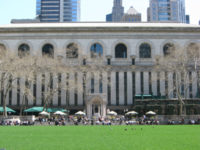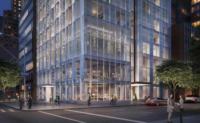Norman Foster hasn’t had great luck in Manhattan—his public library plan seems to have gone off the rails, in part due to the lackluster renderings his firm released last year. And his Hearst Building, at 57th Street and Eighth Avenue, has always looked a little squat; it will seem positively piddling when the spate of new, supertall towers on 57th Street (including an 84-story monolith by Rafael Viñoly) take to the sky.
But maybe Foster will do better with 551 West 21st Street, a 19-story condo building overlooking the Hudson River. Foster’s involvement had been rumored for months, and was finally confirmed by publicists for developer Scott Resnick. Resnick touted the building’s "robust, cast-concrete exterior" and "expansive windows with warm metal surrounds designed to enhance and reflect the location's abundant western light." But with apartments of up to 6,400 square feet, with "French herringbone floors and custom millwork," the focus seems to be on lifestyle more than architecture, a pitfall in an era when buyers are willing to spend $20-to-$80 million on condos and apparently believe that only more is more.
Also designing new condos in New York is Shigeru Ban, who will be setting 13 units atop a landmark six-story cast iron building at 361 Broadway, in TriBeCa. (Ban will be working with his longtime associate, the Manhattan architect Dean Maltz.) And Soo Chan, a young Singaporean architect (part of Record’s Design Vanguard in 2003) has designed a building called Soori High Line, at 522 West 29th Street, that may become known more for its amenities—such as a private swimming pool in each apartment—than its architecture, despite the admirable, almost Zen-like restraint of the glass facade covered in vertical steel-and-timber fins.
The buildings by Foster, Chan, and Ban will be the latest in a new crop of condo buildings by brand-name architects, including Zaha Hadid’s 11-story tower at 520 West 28th Street, which seems to mimic the industrial-age curves of the nearby Starrett-Lehigh Building; Herzog & de Meuron’s multi-cantilevered 56 Leonard Street; Bjarke Ingels’s nearly full-block, pyramid-shaped tower on West 58th Street; and the clover leaf-shaped building by Diller Scofidio + Renfro (in collaboration with Rockwell Group, along with with Ismael Leyva Architects) at the Hudson Yards.
But perhaps the most novel group of condos in Manhattan will be those designed by Robert A.M. Stern for the Sony building—formerly the AT&T building—on Madison Avenue. That famous Philip Johnson gewgaw, with its oversized Chippendale crown, has long been admired or derided as the epitome of post-modern excess. Johnson, who died in 2005, lived in a condo on 53rd Street that he chose in part for its views of AT&T, but probably never imagined actually living in the building. (Sony recently sold it to the Chetrit Group for $1.1 billion, but will continue to occupy it until 2016.) Johnson may well have approved of the choice of his (sometimes) loyal protégé, Stern, the master of gilded age luxury, to design the apartments on the floors where telephone executives once toiled. Yet the building’s $110 million price tag was considered excessive in the 1970s; in today’s overheated market, that sum might buy one or two penthouse units. Johnson, no doubt, would be pleased.













Post a comment to this article
Report Abusive Comment